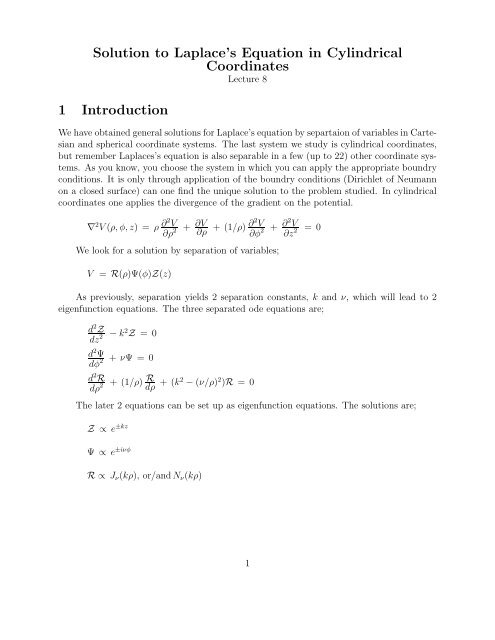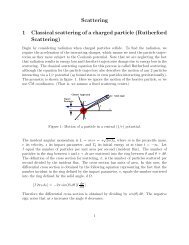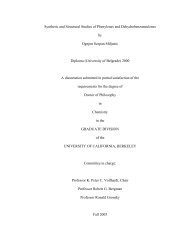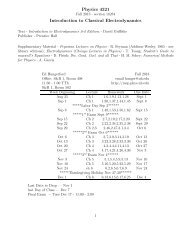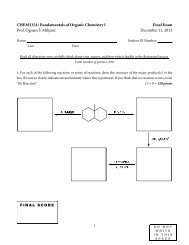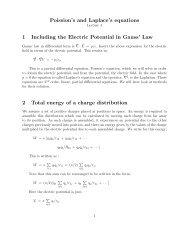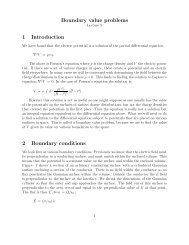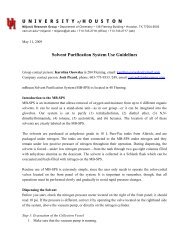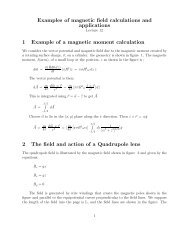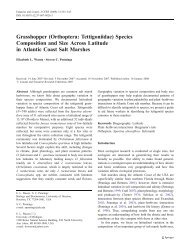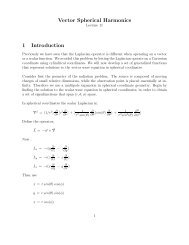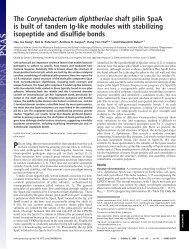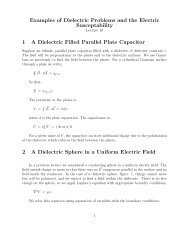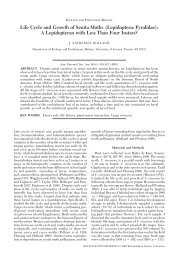Solution to Laplace's Equation in Cylindrical Coordinates 1 ...
Solution to Laplace's Equation in Cylindrical Coordinates 1 ...
Solution to Laplace's Equation in Cylindrical Coordinates 1 ...
- No tags were found...
Create successful ePaper yourself
Turn your PDF publications into a flip-book with our unique Google optimized e-Paper software.
LzV = VoV = 0xV = 0ayFigure 2: The geometry of a cyl<strong>in</strong>der with one eddcap held at potential V = V 0 (ρ) and theother sides groundedIn this case the solution is <strong>in</strong>dependent of the angle φ so we take ν = 0. Note that wehave not <strong>in</strong>cluded N ν <strong>in</strong> the solution because we want it <strong>to</strong> be f<strong>in</strong>ite as ρ = 0. Also we havechosen s<strong>in</strong>h(k n z) <strong>to</strong> satisfy the boundary condition at z = 0. The reduced solution is;V = ∑ nA n J 0 (k n ρ)s<strong>in</strong>h(k n z)Now V = 0 for ρ = a. This means that;J 0 (k n a) = 0The values of k n a are the zeros of the bessel function J 0 (k n a). The first few are, α 0n =2.4048, 5.5201, 8.6537, · · ·. Then at Z = L we f<strong>in</strong>d A n us<strong>in</strong>g the orthogonality of the Besselfunctions.A n = 1a 2 [J 1 (k n a)] 2 s<strong>in</strong>h(k n L)∫ a0ρdρ J 0 (k n ρ) V 0 (ρ)The graphic form of the solution is shown <strong>in</strong> figure 3.As another example we f<strong>in</strong>d the potential <strong>in</strong>side a cyl<strong>in</strong>der when the potential is specifiedon the end caps and the cyl<strong>in</strong>drical wall is at zero potential, figure 4. The boundryconditions are that;V = V 0 s<strong>in</strong>(φ)z = LV = −V 0 s<strong>in</strong>(φ) z = -L4
Figure 3: A graphical representation of the above solutionV = Vo s<strong>in</strong>( φ )zaLyxV = 0−LV = −Vo s<strong>in</strong>( φ )Figure 4: The geometry of the problem with endcaps held at potential V = V 0 ± s<strong>in</strong>(φ)5
zbcaV = f( ρ )V = 0yxFigure 5: The geometry for the problem of two concentric cyl<strong>in</strong>dersV = 0ρ = aThe solution must have the form;V = ∑ νnA νn J ν (k n ρ) s<strong>in</strong>(νφ) s<strong>in</strong>h(k n z)Here we have discarded solutions <strong>in</strong> N νn (kρ) which are <strong>in</strong>f<strong>in</strong>ite at the orig<strong>in</strong>. To matchthe boundry at z = ±L we need <strong>to</strong> have a term s<strong>in</strong>(νφ) which requires ν = 1. Then werequire that the Bessel function, J 1n (k n a) = 0 which determ<strong>in</strong>e the zeros of the Bessel functionof order 1. We write these as α 1n so that k n = α 1n /a. The solution then has the form;V = ∑ nA n J 1 (α 1n ρ/a) s<strong>in</strong>h(αz/a) s<strong>in</strong>(φ)F<strong>in</strong>ally we match the boundry condition at z = ±L where V = V 0 s<strong>in</strong>(φ). Use orthorgonality<strong>to</strong> obta<strong>in</strong>;(L/2)[J 1 (α 1n )] 2 A n = 1s<strong>in</strong>h(αL/a)∫ a0ρdρ J 1 (α 1n ρ/a) V 0As another example we look at a solution for concentric cyl<strong>in</strong>ders with the boundryconditions;r = a, c and z = 0 V = 0z = b V = f(ρ)This geometry is shown <strong>in</strong> figure 56
We choose a solution <strong>to</strong> have the form;∑V = ∞ A n s<strong>in</strong>h(k n z) G 0 (k n ρ)nHere we have written a superposition of the Bessel and Neumann functions;G 0 = [ J 0(k n ρ)J 0 (k n c) − N 0(k n ρ)N 0 (k n c) ]So that at ρ = c, the cyl<strong>in</strong>drical surface of the <strong>in</strong>ner cyl<strong>in</strong>der, G 0 vanishes. Note wehave chosen ν = 0 because the potential is <strong>in</strong>dependent of φ, ie the problem is aximuthallysymmetric. Now we must choose the values of k n <strong>to</strong> make G 0 = 0 when ρ = a. This willselect a set of zeros, α νn , of the function, G 0 , and <strong>in</strong> fact make the functions, G 0 , a completeorthogonal set. This po<strong>in</strong>ts out that we separated the solutions of the radial ode <strong>in</strong><strong>to</strong> aform which was regular at ρ = 0 and one which was not. But we could have separated thesolutions so that, G 0 , was one of the two l<strong>in</strong>early <strong>in</strong>dependent solutions, and thus it wouldhave similar oscillat<strong>in</strong>g properties as the function J ν . Of course the location of the zeroswould be different. Use orthogonality <strong>to</strong> obta<strong>in</strong> the coefficients <strong>in</strong> the above equation.Here;H A n = [1/s<strong>in</strong>h(k n b)]H =∫ acρdρ G 2 (α n ρ/a)∫ acρdρ V (ρ) G(α n ρ/a)F<strong>in</strong>ally consider the problem with the cyl<strong>in</strong>drical wall held at potential V = f(z) andthe endcaps grounded. This geometry is shown <strong>in</strong> figure 6. The boundry conditions are;z = 0, b V = 0ρ = a V = f(z)In this case we cannot use the hyperbolic function <strong>in</strong> z <strong>to</strong> match the boundry conditions.However if we let k → ik then the hyperbolic function becomes harmonic at the expense ofmak<strong>in</strong>g the argument of the Bessel function complex. Note here that the problem is 2-Dso we expect only one eigenfunction and this now occurs for the z coord<strong>in</strong>ate. Then theradial ode with complex Bessel function solutions cannot be eigenfunctions. The eigenvalueof k = nπ/b is determ<strong>in</strong>ed by the harmonic form;s<strong>in</strong>(nπz/b)n <strong>in</strong>tegralThe solution has the form;7
V = 0zaz V = f( )yxV = 0Figure 6: The geometry for the problem where a potential is placed on the cyl<strong>in</strong>drical surfaceand the end caps groundedV = ∞ ∑n=1A n s<strong>in</strong>(nπz/b) J 0 (<strong>in</strong>πρ/b)In this case we use the orthogonality of the harmonic functions rather than the Besselfunctions. The value of the coefficients are;A n =2bJ 0 (<strong>in</strong>πa/b)∫ b0dz f(z) s<strong>in</strong>(nπz/b)8


